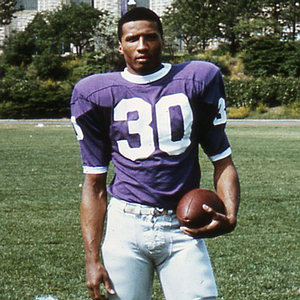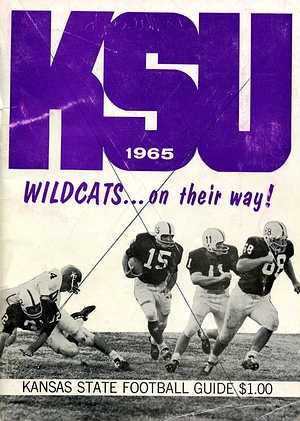Although Kansas State was literally the bottom of the barrel in the Big
Eight Conference, finishing in the cellar four out of five years going into
1965, they were seen as "big time" to many UC athletes. Even while playing a
schedule that was tough, demanding, and included a number of nationally ranked
or known teams, any time there was an opponent from one of the major
conferences or a major independent coming up, there was a general feeling that
their athletes were perhaps a bit more talented or they were tougher because
their level of competition was a notch higher. This is probably the case at
almost every mid-level program that has a few games each year where they have
to "rise up." Cincinnati brought this to ridiculous heights in the mid-1980's
when Mike McGee was the Athletic Director. Just as UC was a stepping stone for
coaches, a number of Athletic Directors also seemed to use the Bearcats as a
means to a better job, one with more prestige, more pay, and more national
notice. Cincinnati served as the homecoming game or an early non-conference
opponent for the likes of Auburn, Florida, Alabama, Penn State, Miami, and
West Virginia. West Virginia perhaps could be considered a natural rivalry as
the schools are not far apart and often competed for the same athletes in the
Steubenville and southern Ohio region but the others? It was strictly for the
money and after two games against that level of opponent, the injury rate was
such that the team could barely compete successfully against schools it should
have faced on even keel the remainder of the season. Kansas State was in the
Big Eight and that was very much the "major show" but it was a team bereft of
stars and success and thus, and equivalent opponent.
When Doug Weaver became yet another in the long line of K-State coaches,
I'm sure he saw a way to find success but his seven year record between 1960
and 1966 was a terrible 8-60-1 and in truth, it was not very much worse than
previous regimes at Kansas State. Weaver was used to success, starring as a
center on Michigan State's great early 1950's teams, one of which was given
careful consideration for the national championship. He served as an assistant
on Duffy Daugherty's staff at his alma mater and then took on the K-State
position. They had difficulty overcoming the advantages of Oklahoma, Kansas,
and Colorado, were difficult to travel to, and just didn't have the tradition
to recruit the best athletes in their conference. They got bombed with Weaver
going 0-10 in 1965 and 0-9-1 in 1966. When they hung him in effigy, he
quipped, "I'm glad it happened in front of the library. I've always emphasized
scholarship." We beat them both years although Cornelius Davis shredded us for
172 yards rushing in 1966, flashing past everyone in his royal purple jersey
and white pants. As "royal purple" was the only official school color, this
left each coach to interpret the "trim" color as they wished. The K-State
helmets in '65 were white with a purple stripe and purple block numerals on
each side. In 1966, they went to an off-set "K-State" logo in purple on the
same white shell, with a large "K" above the word "State". With the purple
stripe and purple trim on white pants, or the away jersey of white with purple
numbers, I thought they had a very sharp uniform. Receiver Dave Jones,
linebacker Danny Lankas, and Davis were excellent players, Lankas' #33 was all
over the field against us, earning him a place on the 1966 All-Opponent team.
K-State just didn't have enough good players to sustain a record of consistent
winning in a tough conference. When Kansas State and Kansas squared off in
their annual in-state battle, one of the most underrated rivalries in college
football, one of the most aspects of the 1966 game was that the K-State fans
were rooting for Kansas so that Weaver would be fired (he would after the
game) and the Kansas fans were rooting for their rivals so that their coach,
Jack Mitchell would be fired. The 3-3 tie resulted in both coaches being
relieved of their duties. Weaver was replaced by Vince Gibson who instituted
his "Purple Pride" campaign which resulted in a few more wins during his
tenure than Weaver had and a great purple helmet. Weaver landed on his feet
ironically as an assistant the next two years on the Kansas staff of Pepper
Rogers in 1967 and '68 and later became Athletic Director at Michigan State
after leading the football program at Southern Illinois. The Michigan State
indoor football facility is named after Coach Weaver, a fitting tribute from
his alma mater.
Kansas State's fortunes were revived with the arrival of Bill Snyder who
was hired on November 30, 1988 for the 1989 season. His genius turned around a
program that had a number of the "top ten" losing streaks of all time in
college football and under his tutelage, K-State became one of the midwest's
powerhouse teams. He also commissioned the development of what became the "Powercat"
logo which is now synonymous with high caliber, winning football. Coach Snyder
announced his retirement but a few weeks ago but he leaves the infrastructure
of the program as one of the best in the country.



